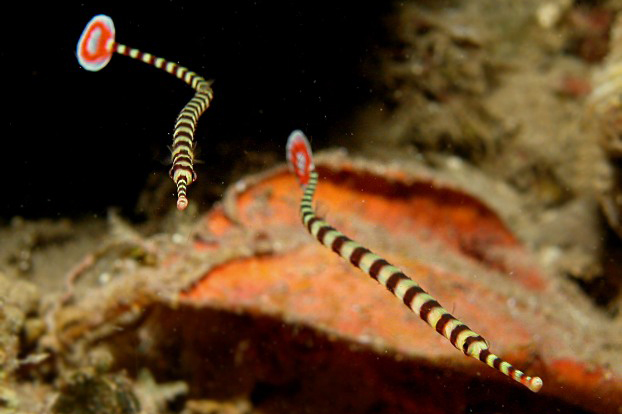- Classification
- ACTINOPTERYGII
- SYNGNATHIFORMES
- SYNGNATHIDAE
- Dunckerocampus
- dactyliophorus
Banded Pipefish, Dunckerocampus dactyliophorus (Bleeker 1853)

A pair of Banded Pipefish, Dunckerocampus dactyliophorus, at Tufi Wharf, Tufi, Papua New Guinea. Source: Dave Harasti / www.daveharasti.com. License: All rights reserved
This distinctive pipefish has alternating pale and red to blackish bands, a reddish caudal fin with white dorsal and ventral margins, and usually 1-3 white spots in the centre.
Banded Pipefish, Dunckerocampus dactyliophorus (Bleeker 1853)
More Info
|
Distribution |
Tropical Western Pacific, from Indonesia, the Ryukyu Islands, Japan, to Australia, the Coral Sea, and east to Marshall and Society Islands, Tonga and Samoa; in Australian waters, known from Rowley Shoals, Western Australia, the Northern Territory, and the Great Barrier Reef, Queensland. Inhabits protected reefs and lagoons, usually in caves and crevices to 10 m. |
|
Features |
Dorsal fin 20-26; Anal fin 4; Pectoral fin 18-22; Trunk rings 15-17; Tail rings 18-22. Head long, 3.7-4.6 in SL, snout long, 1.4-1.8 in head length, snout depth 10.6-20.8 in snout length. Superior trunk and tail ridges discontinuous; lateral trunk ridge continuous with inferior tail ridge; juveniles with 2 spines on ridges of body, reduced to 1 spine in adults and may be lacking in large adults. Caudal fin moderately large. |
|
Size |
Grows to about 180 mm TL |
|
Colour |
Head (including the snout) and body with alternating pale and red to black bands; caudal fin usually red with white dorsal and ventral margin and usually 1-3 white spots in the centre. |
|
Fisheries |
This popular species is collected for the aquarium trade. |
|
Conservation |
Marine listed under the Environment Protection and Biodiversity Conservation Act 1999(as Doryrhamphus dactyliophorus). |
|
Remarks |
Some records of D. dactyliophorus may actually be of the relatively recently described D. naia, which is known from Fiji and Indonesia and may also occur in southern Japan, northern Sulawesi, Guam, and the Solomon Islands (on the basis of underwater photographs). |
|
Similar Species |
D. dactyliophorus is easily confused with D. naia, which has a similar pattern of light and dark bars, however the bars of D. naia are lighter and have a reddish hue. The caudal fin of D. naia is mostly red and the white margin is confined to the top and bottom of the caudal fin. D. boylei, which has a broader bands and a diagnostic caudal fin pattern, has previously been confused with D. dactyliophorus. |
|
Etymology |
The specific name dactyliophorus is from the Greek dactylos (= finger) and the Latin pharus (= beacon, lighthouse), in reference to the distinctive white spot on the caudal fin. |
|
Species Citation |
Syngnathus dactyliophorus Bleeker 1853, Nat. Tijdschr. Ned. Ind. 4: 506. Type locality: Onrust Island, Jakarta (as Batavia), Indonesia. |
|
Author |
Bray, D.J. & Thompson, V.J. 2025 |
|
Resources |
Banded Pipefish, Dunckerocampus dactyliophorus (Bleeker 1853)
References
Allen, G.R. & Erdmann, M.V. 2012. Reef fishes of the East Indies. Perth : Tropical Reef Research 3 vols, 1260 pp.
Allen, G.R. & R.H. Kuiter. 2004. Dunckerocampus naia, a new species of pipefish (Pisces: Syngnathidae) from the western Pacific. Aqua, Journal of Ichthyology and Aquatic Biology 9(1): 1-6.
Allen, G.R. & R. Swainston. 1988. The marine fishes of north-western Australia. A field guide for anglers and divers. Western Australian Museum, Perth. 201 pp.
Bleeker, P. 1853. Diagnostiche beschrijvingen van nieuwe of weinig bekende vischsoorten van Batavia. Tiental I-VI. Nat. Tijdschr. Ned. Ind. 4: 451-516.
Dawson C.E. 1985. Indo-Pacific Pipefishes (Red Sea to the Americas). Gulf Coast Research Laboratory, Ocean Springs, Mississippi. 230 pp.
Dawson, C.E. & J.E. Randall. 1975. Notes on Indo-Pacific Pipefishes (Pisces: Syngnathidae) with description of two new species. Proc. Biol. Soc. Wash. 88(25): 263-280.
Hoese, D.F., D.J. Bray, J.R. Paxton & G.R. Allen. 2006. Fishes. In Beesley PL & Wells A (eds) Zoological catalogue of Australia. Volume 35. ABRS & CSIRO Publishing: Australia. 2178 pp. [as Doryrhamphus dactyliophorus].
IUCN. (2008). 2008 IUCN Red List of Threatened Species http://www.iucnredlist.org/
Kuiter, R.H. 1997. Guide to sea fishes of Australia. A comprehensive reference for divers and fishermen. New Holland Publishers, Frenchs Forest, NSW, Australia. 434 pp.
Kuiter, R.H. 1998. Pipefishes of the syngnathid genus Dunckerocampus (Sygnathiformes: Syngnathidae), with a description of a new species from the Indian Ocean. Aqua, Journal of Ichthyology and Aquatic Biology 3(2): 81-84.
Kuiter, R.H. 2000. Seahorses, Pipefishes and their Relatives. TMC Publishing, Chorleywood, UK. 240 pp.
Masuda, H., K. Amaoka, C. Araga, T. Uyeno & T. Yoshino. 1984. The fishes of the Japanese Archipelago. Vol. 1. Tokai University Press, Tokyo, Japan. 437 pp.
Michael, S.W. 1998. Reef Fishes Volume 1. A Guide to Their Identification, Behaviour and Captive Care. Microcosm Ltd. Shellbourne, Vermont. 624 pp.
Myers, R.F. 1999. Micronesian reef fishes: a comprehensive guide to the coral reef fishes of Micronesia. 3rd revised and expanded edition. Coral Graphics, Barrigada, Guam. 330 pp.
Myers, R.F. & T.J. Donaldson. 2003. The fishes of the Mariana Islands. Micronesica 35-36: 598-652.
Nakabo, T. 2002. (Ed.) Fishes of Japan with pictorial keys to the species. English edition. Tokai University Press. 866 pp.
Paulus, T. 1999. Family Syngnathidae. (p. 2264-2276) In Carpenter K.E. & V.H. Niem (eds). The Living Marine Resources of the Western Central Pacific. FAO Species Identification Guide For Fisheries Purposes. FAO Vol. 4.
Pogonoski, J.J., D.A. Pollard & J.R. Paxton. 2002. Conservation Overview and Action Plan for Australian Threatened and Potentially Threatened Marine and Estuarine Fishes. Environment Australia, Canberra. 375 pp.
Randall, J.E. 2005. Reef and shore fishes of the south Pacific. University of Hawai‘i Press Honolulu. 707 pp.
Randall, J.E., G.R. Allen & R.C. Steene. 1997. Fishes of the Great Barrier Reef and Coral Sea. 2nd Revised and expanded edition. Crawford House Publishing Pty Ltd., Bathurst, NSW, Australia. 557 pp.
Sorensen, M. & Vincent, A. 2010. Doryrhamphus dactyliophorus. The IUCN Red List of Threatened Species. Version 2015.2.






